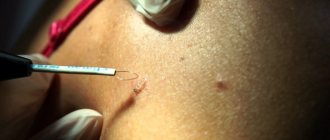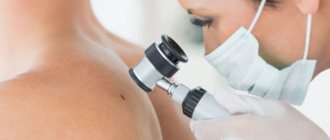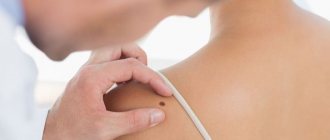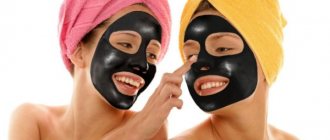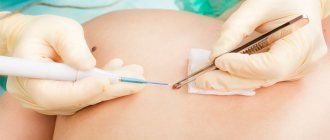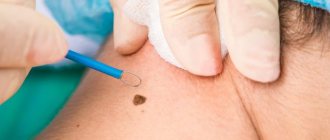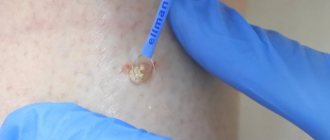Moles and papillomas
Moles are commonly called pigmented formations on the skin. Doctors gave them another name - nevi. They are formed from pigment cells. In fact, a mole is a benign tumor. Most often it is located between the epidermis and dermis. Sometimes one or more moles can be found on the mucous membranes. For example, in the mouth or vagina. Nevi can be of different colors: brown, purple, black, blue, red and others. Sometimes moles are colorless. The reasons for their formation are as follows: Some papillomas, in appearance, are similar to colorless moles. Sometimes they grow and resemble cauliflower. These tumors most often form on the face, neck and chest. The cause of such growths is the human papillomavirus. Infection occurs as follows:
- Sexually.
- Autoinfection. For example: during hair removal or shaving.
- Infection of the baby during childbirth.
- By everyday means. The virus enters the body through microscopic abrasions or cuts in the skin.
In most cases, the reason for removing moles and papillomas is aesthetics, not health. The patient simply does not like the appearance of the growth or it is too noticeable to others. In some cases, neoplasms are traumatized by clothing or a chain around the neck. This forces the patient to see a doctor to get rid of the growth.
What are moles? What are they?
To answer this question, you must first clarify what we mean by the word “mole.” An ordinary person can easily find several types of skin formations. Brown, red, flesh-colored - all these can be called moles. In fact, the World Health Organization (WHO) classification of benign skin lesions includes about 150 names. And all this diversity can also be called moles. Read a little more about the most common types of moles here.
As we said above, there are a huge number of types of moles. Today we will talk about those that are most common and, theoretically, can pose the greatest danger - brown and flesh-colored moles.
Why remove tumors
Moles and papillomas can pose a real threat to human health and even life. For example, a nevus can degenerate into one of the most aggressive types of cancer - melanoma. Usually the tumor progresses rapidly, since the body’s response is weak or absent altogether. Strong immunity can suppress the development of the papilloma virus. Often, the growths that appear disappear on their own without a trace. If the immune response is insufficient, the tumor will not disappear. It may even increase in size. In place of one papilloma, several appear at once. The growths can become injured and become infected. In addition, papilloma can cause the development of squamous cell carcinoma and other types of cancer. Removal of moles and papillomas can be carried out only after consultation with a doctor.
If there is a suspicion of malignant degeneration of the nevus, it must be eliminated with extreme caution and only in a medical facility. After the procedure, tissues are necessarily sent for histological examination. The same is done with suspicious papilloma. In this case, the optimal way to remove the tumor is surgery. Fortunately, not all nevi and papillomas are dangerous. They rarely develop into melanoma or other types of cancer. Most often, patients remove moles and papillomas for aesthetic reasons.
Causes
Why do moles appear on the skin? Every experienced mole doctor will say that there are several reasons for their appearance on the body:
- ultraviolet radiation;
- traumatic damage to the epidermis;
- systematic violation of the integrity of the skin;
- negative influence of radioactive background;
- Constant consumption of unhealthy foods, smoking, drinking alcoholic beverages. Because of this, moles on the body constantly grow;
- problems in the functioning of the endocrine system, changes in hormonal levels;
- hereditary predisposition.
Laser Application
A dermatologist can offer the patient several ways to remove tumors. Naturally, the patient will give preference to the one that is the least traumatic and painless. Laser removal of papillomas and warts allows you to quickly get rid of the problem.
The microfractional beam evaporates the growth without affecting healthy tissue. To completely remove the tumor, one procedure is sufficient. There are no scars after using the laser. In addition, blood loss is also excluded.
- Diabetes.
- Blood diseases.
- Oncology.
- Pregnancy.
- Autoimmune diseases.
- Tendency to keloid scars.
- Epilepsy.
After the procedure, the wound heals within two weeks. Many patients who have chosen this method of treatment leave positive reviews on the Internet. The consequences of laser removal of papillomas and moles are clean and healthy skin. Just a few days after the procedure, the patient completely forgets about the eliminated growths. There are no side effects after using the laser.
Prevention of pigmentation
Pharmacy and cosmetic ointments will get rid of dark spots on the skin, and prevention will help consolidate the result. It is worth reviewing your diet: include foods with antioxidants in the menu, replace coffee with green tea or cocoa, and red wine is acceptable from alcohol.
Follow the rules for staying in the sun. If the skin is predisposed to pigmentation, then it is better to minimize ultraviolet rays. Choose products with an SPF level of at least 30, cover exposed skin with clothing, and keep sunbathing time to a minimum. Before going to the resort, do not do laser hair removal; the procedure increases the negative effects of ultraviolet rays.
Doctors and cosmetologists advise regularly performing a complete check-up of the body. To do this, get tested, visit an endocrinologist, gastroenterologist, gynecologist and therapist. Listen to all the signals from your body, in particular the dark spots on your face and body. Problematic skin requires treatment, because pigmentation spoils the appearance and indicates underlying problems.
Add to cart
Underarm skin brightening treatment
RUB 1,400.00
Add to cart
Whole body skin lightening milk
RUB 4,100.00
Add to cart
Cream Lakshma Maxxi (Lakshma Maxxi)
RUB 2,100.00
Add to cart
Radio wave removal
Radioknife is another effective means for removing moles and papillomas. But it can only be used if the doctor is sure that malignancy of these tumors has not occurred. In addition, the radioknife is contraindicated for pregnant women and people who have a heart rate sensor in their body. High-frequency waves evaporate nevus or papilloma cells. Healthy tissues are not harmed. The operation is painless and lasts no longer than 25 minutes. There is no bleeding, so there is no need for postoperative wound care.
How do creams work?
All products that even out skin tone and whiten are useful thanks to the active substances in their composition: niacinamide, oligopeptides-34, 24, decopeptides-4, lumixil, decopeptide-12, retinol, nicotinic acid and much more. Therefore, read the instructions and composition of the drug. Common substances included:
- niacinamide – one of the main components, helps whitening and regeneration of epidermal cells;
- retinol – reduces melanin production;
- azelaic acid – inhibits melanin synthesis and has an antibacterial effect;
- kojic acid – helps regeneration and formation of new cells and whitens;
- nicotinic acid – participates in reduction and oxidation reactions;
- Tretinol – stimulates cellular regeneration;
- arbutin – inhibits discoloration and prevents stains from spreading to other areas;
- Dandelion extract – whitens, disinfects and vitaminizes the dermis.
These components must be included in the composition, since they are the best remedy for age spots on the face and body.
A common cause of the problem is improper tanning. During summer holidays, use spf 50 sunscreen, which is best for the face against age spots? SPF (Sun Protection Factor) is the level of protection, “sun protection factor”. After the abbreviation SPF there are numbers: 15, 30 or 50. The most effective product has SPF 50 and protects against 99% of UV rays.
Electrocoagulation
High-frequency current is often used to combat tumors. This method of removing moles and papillomas is quite painful, so the doctor must use anesthesia. During the procedure, the doctor brings a special needle to the head of the growth, which conducts an electric current. A spark occurs between the device and the skin. It burns the neoplasm cells to the very foundation. There is no blister after the procedure. But a scar forms on the surface of the skin, which resolves over time.
Sunscreens to prevent
By the first 10 years of life, nevi already appear on the child’s body. They are often safe and do not cause any discomfort. The pigment melanin provokes the appearance of moles, coloring them in a spectrum from light yellow to dark brown. Sunscreen is the best way to prevent the appearance of new nevi, age spots, freckles and burns. Special filters help protect the skin from ultraviolet radiation without provoking the active work of melanin. When properly selected for your skin type, a ton of skin color, structure and uniformity have the most positive effect. It should be applied 2 hours before going outside, repeating the procedure if necessary.
Virtually every cosmetic brand offers products with SPF protection in their product line. Well-known cream manufacturers are NIVEA, Estel, Vichy, Inglot and others. The popularity of these brands depends on the quality of the product, the price of the product, and the versatility of the approach to different skin types. Available with varying degrees of protection. Trial packs of mole creams (samples) are sold so you can choose the best option for yourself without buying a large quantity blindly.
A liquid nitrogen
Effective methods for removing moles and papillomas include cryodestruction. The procedure uses liquid nitrogen, the temperature of which reaches -196 °C. This substance freezes the liquid in the altered cells, after which they are completely destroyed. The procedure is painless, so there is no need for anesthesia. After using liquid nitrogen, crusts may remain at the site of the growth. They are completely rejected after two weeks. As a rule, there are no scars at the site of removal of a mole or papilloma. Unfortunately, this method cannot be used if a tumor biopsy is required.
What if a scar appears?
Once scar tissue has formed, unfortunately, it will not be possible to completely get rid of it. All medical actions in this case will be aimed at minimizing the manifestations of the scar. The following methods are used to treat formed keloids:
- GCS injections are a popular and effective method for treating keloid and hypertrophic scars. A GCS solution is injected into the scar tissue 1–2 times a month until the expected results appear. Unfortunately, with excessive use of the drug, skin atrophy may develop at the injection site, telangiectasia or an atrophic scar may appear. [4]
- Surgical excision of the scar - you should not resort to this method as the only remedy, since it always ends in a relapse that exceeds the existing scar in area. This method can be resorted to after previous long-term therapy carried out in various ways. [4]
- Cryotherapy is the treatment of scars with liquid nitrogen. There are various methods of its use: spray, contact method and intralesional cryoprobe. The latter method is more effective. In addition, the combination of cryotherapy with GCS injections gives the best result compared to others. [4]
- Laser treatment – various lasers are used. Nd:YAG laser with a wavelength of 1,064 nm is used to target the vessels of scar tissue. In addition, CO2 and Er:YAG lasers are actively used in fractional mode. But it is not recommended to use ablative lasers (CO2 and Er:YAG) as the only treatment method, since in this case there is a high probability of relapse. [5]
A dye laser (PDL) with a wavelength of 585 nm is also considered effective. [6]
There is evidence of the effective use of CO2 laser in fractional mode during surgery to improve the cosmetic outcome of healing. [7]
- Ointment with 5-fluorouracil for the treatment of scars, but it is not sold in Russia. [4]
- Botulinum toxin type A is used to weaken the tension of the wound edges by reducing muscle activity. Injections are given immediately after surgery. [8]
- Imiquimod cream is recommended for use after surgical excision of a scar to minimize the likelihood of recurrence. [9]
- Other methods - bleomycin, verapamil, TGF-β, interferon, tacrolimus, sirolimus, tamoxifen, epidermal growth factor, retinoic acid, tamoxifen and other drugs are also considered effective for the treatment of scars. [10]
Surgical intervention
The safest way is to remove moles and papillomas using a surgeon's scalpel. It is this method that is used if there is a suspicion of malignant degeneration of the growth. The operation is performed using anesthesia, so it is comfortable for the patient. Surgical intervention guarantees complete removal of the tumor, unlike laser or cryodestruction. In addition, the risk of relapse is eliminated. Many patients do not know where to remove papilloma and mole - in a private clinic or a public one. In fact, it all depends on the experience of the surgeon. It is important to find a qualified doctor. As practice shows, most often such specialists work in government agencies.
There are no contraindications to surgical removal of growths. Sometimes it is necessary to postpone the procedure. The doctor will advise you to undergo surgery in the following cases:
- Pregnancy and breastfeeding.
- Exacerbation of herpes.
- Inflammatory process.
- Exacerbation of a chronic disease.
- Viral or bacterial infection.
The duration of the operation usually does not exceed 60 minutes. After excision of the tissue, the doctor applies stitches. If necessary, the removed nevus or papilloma is sent for histological examination. The wound is treated with an antiseptic daily. Do not remove the resulting crust yourself. In addition, the affected area must be protected from exposure to sunlight for two to three months. Non-absorbable sutures are removed 10 days after the intervention. A barely noticeable scar remains after the operation. If the neoplasm was located quite deep, a more pronounced mark may remain. You can smooth it out using a special patch or absorbable cream.
I monitor one mole, remove another: how not to miss dangerous neoplasms on your skin
Where do they come from
On the Internet you can find a version that our moles initially grow... due to tanning. They say that a person is born with clear skin, and over time it is because of the sun that moles appear on it.
“In fact, the formation of moles and their number is determined primarily by heredity,” says dermato-oncologist at the Clinic of Skin Diseases, assistant at the Department of Skin Diseases at Sechenov University, candidate of medical sciences Ekaterina Vertieva.
- That is, those who have a lot of new growths on the skin in their family - mom, dad, grandmother or grandfather - will have more moles.
The second factor is the sun. Under the influence of its rays, the number of moles increases.
At the same time, there are several peaks in a person’s life when most moles appear. Such surges are associated with hormonal changes: at a younger age (3 - 6 years), adolescence and from 25 to 35 years. Women may experience additional peaks during pregnancy.
— Is it true that there is a “safe limit” of moles, and if there are more than normal, then a person has an increased risk of skin cancer?
— If there are more than a hundred moles on the skin, then the risk of malignant neoplasms is really higher. But not so much that those with a rich scattering of moles should immediately sound the alarm. The logic is simple: the more tumors there are, in principle, the higher the likelihood that among them there will be nevi with malignant potential (how to protect yourself from danger - see below).
STAY IN TOUCH
What is what
Among the names of growths on the skin you can find the classic, familiar word “mole,” as well as nevus and keratoma. What is the difference?
“ Nevus is the medical name for the same mole,” explains Ekaterina Vertieva. - Essentially, this is a benign skin tumor. A mole consists of pigment cells of melanocytes, which produce the coloring pigment melanin (because of it, our skin darkens when tanning. - Ed.) A mole is a cluster of such melanocyte cells. That is why the appearance of nevi is associated, among other things, with exposure to the sun.
— Keratoma is a benign superficial formation on the skin that can never degenerate into something malignant. Keratomas occur more often in old age. They consist of keratinocyte cells (these are the surface cells of the upper layer of the skin of the epidermis). Externally, a keratome usually looks like a brown formation rising above the surface of the skin. Keratomas often become crusty and flaky. Pieces can fall off, which scares people. In fact, this is a natural desquamation process. There is no need to be scared, the doctor reassures.
On a stem and with hairs - what can you expect from them?
- There are moles that seem to move away from the skin and rise above it - is this dangerous?
- Look: we have superficial layers of skin, the epidermis, and deep layers, the dermis. Common, classic dark moles are superficial, so-called border nevi. They are found in the epidermis. Over time, some superficial nevi absolutely physiologically, that is, safely, naturally grow into the deep layers of the skin, the dermis. And then they begin to rise above the surface of the skin. Nothing wrong with that.
Moreover, over time, by about 50-60 years, dermal nevi completely lose their pigment. They cease to be brown and acquire the color of healthy skin. This is the so-called mole involution. All this is absolutely safe.
- When do hairs grow from a mole? They say this is a good sign, such nevi are definitely safe and will not degenerate into melanoma.
- This is a misconception. Melanoma can easily grow hair. Therefore, if a nevus has suspicious signs (see below), then the hairs are not a reason to calm down and not check the mole.
By the way, doctors categorically do not advise pulling hair out of a nevus; this is unnecessary trauma. You can only cut it carefully.
Meyerson phenomenon
This is the name of the condition when redness appears around the mole, like an inflamed pink corolla, our expert explains. And it reassures: as a rule, it is not dangerous. Most often, the Meyerson phenomenon occurs in patients with a tendency to skin diseases: eczema, atopic dermatitis. If you experience any discomfort or itching, you should consult a doctor. Usually, dermatologists prescribe atopic corticosteroids to relieve such symptoms; with their help, the symptoms are easily removed.
— If you damage a mole and it bleeds, do you need to see a doctor urgently?
— It is necessary, but not necessarily right on the same day or the next day, up to 7 days is quite normal. There is no need to be afraid that after injury, even with bleeding, your mole will definitely degenerate into something bad. Do not believe the stories about a grandmother who picked off a mole, it immediately metastasized into the blood, and death quickly occurred. It is a myth. If a person injures a benign mole, then nothing bad will happen to it. Adverse consequences occur if it was initially melanoma.
— What to do immediately after a mole is damaged, before going to the doctor?
- Treat with a clear antiseptic. Hydrogen peroxide, for example. Just don’t smear it with fucorcin, iodine or brilliant green. Because it will then be difficult for the doctor to examine and assess the condition of your mole due to staining with these substances.
How often to check with a doctor
There are tips on the Internet to show your moles to a doctor every 6 to 12 months.
“If a person has 100 or more nevi and is advised to visit a doctor every six months or a year, then this is still too much,” says Ekaterina Vertieva. - In most cases, moles will not turn into anything bad. But, to be sure of this, it is important to undergo a full examination once by a dermatologist, or even better, an oncodermatologist. Have a specialist carefully check all moles and confirm that none of them are cause for concern. Or he indicated those that could potentially be dangerous, and then told how often they need to be monitored.
If the doctor, after examination, says that all moles are calm, then, as a rule, it is recommended to see the next time in 3 - 4 years. At the same time, no one canceled the self-examination.
THIS WILL BE USEFUL
The golden rule for self-examination
This is the international standard for assessing moles. It can be used as a test at home. The mole is tested according to the ABCDE criteria.
A (asymmetry, asymmetry) - has the mole become asymmetrical?
B (border) - have the borders of the mole become uneven?
C (colour) - has the color of the mole changed: several shades of brown, black, blue, pink have appeared?
D (diameter, diameter) - has the mole grown more than 6 mm in diameter?
E (evolution, evolution) - does the mole change intensively over 4 - 6 months (in shape, color, size)?
Important : if the answers to all questions are “yes,” this is reason to suspect the mole is malignant and immediately consult a doctor. If you have several of the symptoms, then the risk is lower, but you also need to see a doctor.
Delete cannot be saved
“There are three reasons for removing moles,” says Dr. Vertieva. — Cosmetic removal — if a person simply doesn’t like the way a mole looks. We also recommend removing benign moles if they are located in places where they are often injured. For example, for men in the beard area, for women in the bra clasp area. The third option is if we see suspicious symptoms. In these cases, the doctor conducts an examination using a dermatoscope (a device similar to a microscope. - Ed.). If a mole is causing concern, removal is done for medical reasons.
— What are the current methods for removing moles?
- Laser, radio wave method, electrocoagulation (cauterization of the nevus with high-frequency current) are used - these methods destroy the mole. As well as surgical excision.
If the patient has a suspicious nevus, then surgical removal is necessary. Only in this case, the tumor tissue is fully preserved, and histologists will be able to give a reliable conclusion as to whether there are malignant cells in the mole.
In other cases, when the mole is definitely calm, the least traumatic method is the radio wave method or laser (coagulation is a rougher method). After removing the nevus, a neat wound remains; it must be treated with a solution of potassium permanganate or fucorcin. A crust forms, which falls off after an average of two weeks. You can wet the wound site with water from 3 to 4 days.
I strongly do not recommend self-medicating at home and using celandine to remove tumors. At best, this technique leads to a chemical burn, and sometimes to more serious consequences in the case of malignant potential of the formation.
QUESTION ON THE TOPIC
Is it possible to sunbathe if you have a lot of moles?
“Yes, this is not a contraindication for tanning,” our expert rejoices. — The main thing is to follow safety rules: stay in the sun before 11 a.m. and after 4 p.m. And use sunscreen.
BREAKTHROUGH AND PROSPECTS
“Now there is a real revolution in the treatment of melanoma, the most aggressive skin cancer,” says Ekaterina Vertieva. — Previously, chemotherapy was used, which was very toxic and at the same time extended the life of patients by only a couple of months. Since the beginning of the 2010s, targeted drugs have been used. They do not hit all cells of the body, like chemotherapy, but selectively hit specific targets. These drugs are available in Russia under compulsory medical insurance and prolong the life of our patients very significantly. The main trend now is the study of new targets for the fight against melanoma. And also immunotherapy (the method for which the Nobel Prize in Medicine was awarded this year. - Ed.).
CONGRATULATIONS!
The oldest department of Sechenov University is 150 years old
On May 27, the Department of Skin and Venereal Diseases named after. V.A. Rakhmanov Sechenov University - 150 years. Already in the first years of its work, the department was recognized as the best in Europe. Over a century and a half history, vast experience in teaching the science of dermatovenereology has been accumulated here. Today, about 2,500 skin and venereal diseases are known, say department employees. The most common are psoriasis, atopic dermatitis, eczema and fungal infections; In recent decades, there has been a steady increase in the incidence of allergic dermatoses.
The head of the department, Professor Olga Olisova, lists modern promising scientific developments of the department's employees: improving the early diagnosis of lymphoproliferative skin diseases (T-cell lymphomas) using genetic markers; development of hardware methods for diagnosing melanocytic skin neoplasia; studying the pathogenetic connections of HPV with the development of skin tumors using molecular genetic detection methods; development of diagnostic markers for severe bullous dermatoses and orphan skin diseases (using the example of mastocytosis).
BY THE WAY
At the Department of Skin and Venereal Diseases of Sechenovka, a unique plaster museum has been created, containing more than 3,000 wax plaster casts with images of various skin and venereal diseases. In terms of the quality and quantity of exhibits, the dummy museum is a national treasure that has no equal not only in Russia, but throughout the world.
Pharmacy preparations for freezing tumors
A doctor must remove moles. You cannot do this on your own. Otherwise, you can provoke a malignant degeneration of the nevus. You can remove papillomas yourself. Provided that the doctor has previously examined the patient and confirmed the diagnosis. And also approved the method of treatment. To do this, you can purchase a remedy for papillomas at the pharmacy, which freezes tumors. The most effective drugs include:
- "Wartner Cryo". Removes not only papillomas, but also warts. The active ingredient of the drug has a temperature of minus 40 degrees, this is quite enough to destroy the cells of the growth;
- "Veruklin". The mixture of gases of this drug has a temperature of minus 50 degrees. The papilloma completely dies off just two weeks after using this remedy;
- "Cryopharma". Contains propane and dimethyl ether. At the exit from the cylinder, their temperature reaches minus 57 degrees. One package is enough to treat 12 tumors. Within two weeks after the procedure, healthy skin is completely restored.
No independence.
Some people believe that you can remove moles yourself by tying them, for example, with silk thread. This is a deep misconception. Attempts to bandage warts and papillomas with a thin silk thread often only provoke the growth of these formations. Today, there are celandine-based preparations on sale that are intended to eliminate warts. But it is better not to remove moles, papillomas, or warts yourself by any means. Celandine juice is similar in composition to iodine, so prolonged exposure to the drug causes skin burns. Cauterization with iodine is even more dangerous - it is more aggressive than celandine. Trying hard to get rid of papillomas with iodine, you can get scars on the skin. Only a dermatologist can properly remove a mole.
Preparations with a cauterizing effect
Pharmacological companies create various effective and affordable drugs for removing tumors at home. Cauterizing remedies for papillomas help get rid of growths forever. The following drugs can be purchased at the pharmacy:
- “Verrucacid.” It is an oily liquid whose main ingredient is phenol. The substance is quite aggressive. The liquid should be applied with an applicator exclusively to the neoplasm. Care must be taken to ensure that the product does not come into contact with healthy tissue. “Verrukatsid” is applied twice with an interval of five minutes. Usually one procedure is enough. The drug is contraindicated for the treatment of pregnant women and children under the age of seven.
- "Ferezol". This drug has a bactericidal and cauterizing effect. The liquid is applied pointwise, several times over the course of an hour. The procedure is repeated after eight days.
- "Solcoderm". This medicine contains oxalic, nitric, acetic and lactic acid. It is recommended to use the drug under the supervision of a specialist with higher or secondary medical education. “Solcoderm” is applied several times pointwise until the neoplasm takes on a yellowish or gray-white color.
Review of pharmaceutical products for mole removal
Pigment spots are removed using the same drugs that are used to eliminate HPV formations - papillomas.
The most effective and popular drugs from the pharmacy are:
- Collomak is a solution with keratolytic properties. Getting on the surface of a mole, it provokes tissue softening. Apply 1 drop of the drug twice a day for 3 to 5 days. Can be applied to the skin of the following parts of the body: face, neck, intimate area.
- Stefalin is a herbal-based ointment. The drug causes a lot of controversy. On the one hand, according to consumer reviews, the effect of use is quite positive - the mole completely disappears from the surface of the skin. On the other hand, there is no information about the manufacturer of the product and clinical studies of this medicine.
- Supercelandine is a preparation that has nothing to do with the medicinal plant; it contains a mixture of alkalis. When applying the solution to the formation, it starts the process of tissue necrosis.
- Dermavit is a product for removing skin lesions. Quickly and almost completely eliminates any growths. Apply Dermavit to the damaged area, avoiding contact with healthy skin. May cause minor irritation in nearby areas. The course of treatment is 1 – 1.5 weeks.
- Mountain celandine is an extract of medicinal celandine extract. Produces a cauterizing effect. Effective for eliminating growths on sensitive areas of the skin. Contact of the substance with mucous membranes and eyes is unacceptable.
- Cryopharma, Wartnerkrio – aerosols for cryodestruction. Analogue of liquid nitrogen. The drug contains special chemical compounds that, upon contact with the formation, lower the temperature of the treated area. The cells gradually break down and die. Complete elimination of the mole can be observed 2 weeks after application of the product.
- Aldara is a drug for eliminating skin growths. The active substance Imiquimod has a destructive effect on the mole, thereby causing its complete death. When used, a local inflammatory reaction is possible, which disappears during treatment.
It is not advisable to use products like Verrucacid or Ferozol to remove moles. In the instructions for the drugs, nevi are in the list of contraindications.
When using any topical products, you should consult your doctor. If the doctor approves such an event, before the procedure you need to carefully read the instructions for the medicine and make sure there are no contraindications. Safety precautions should be taken: protect hands and healthy skin from contact with the product.
Those who do not welcome pharmaceutical drugs can use traditional methods of removing age spots. For these purposes, traditional healers recommend using vinegar, iodine, and celandine juice. Such recipes should be discussed with your doctor before using them.
Rules for choosing an effective lightening product for the face
- Buy only products from professional cosmetic brands . Cheap drugs and widely available products will not contain the necessary substances/concentrations for effective depigmentation.
(the advice is banal, but it will allow you to avoid unnecessary waste of money and time)
- Use preparations with a complex composition of lightening ingredients .
There are many mechanisms that bring pigment cells into a state of hyperproduction of the melanin pigment, and it is also necessary to block these processes in a comprehensive manner. Look for products with a composition of brightening ingredients that work at different points of application and enhance each other's effects.
- Remember that your daily care should at least include the use of a lightening cream + sunscreen !
Free consultations are available from leading cosmetologists of the Russian representative office of DermaQuest and Circadia.


